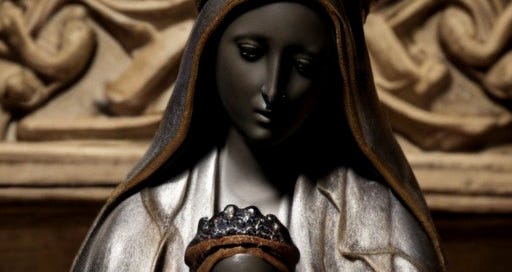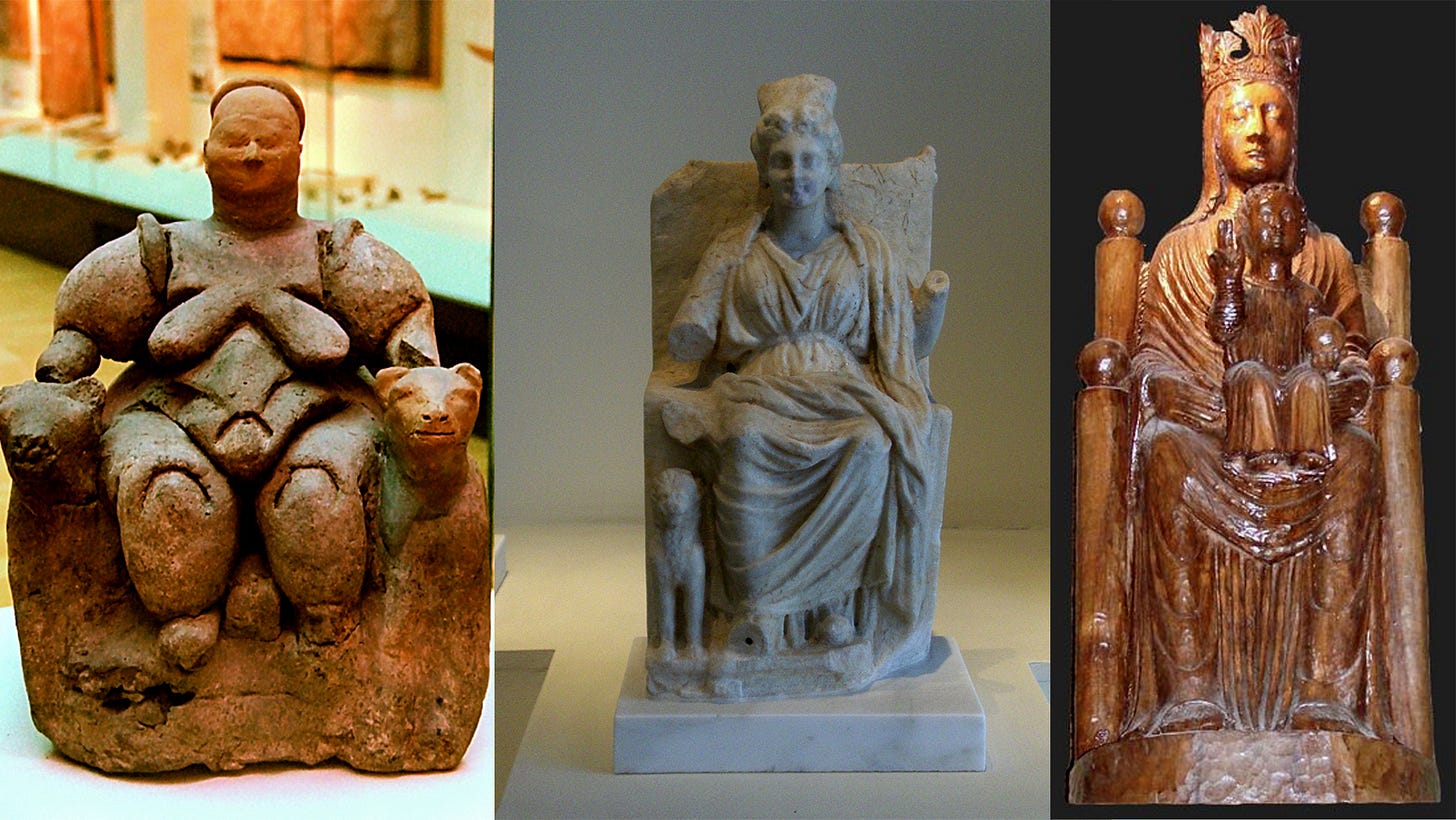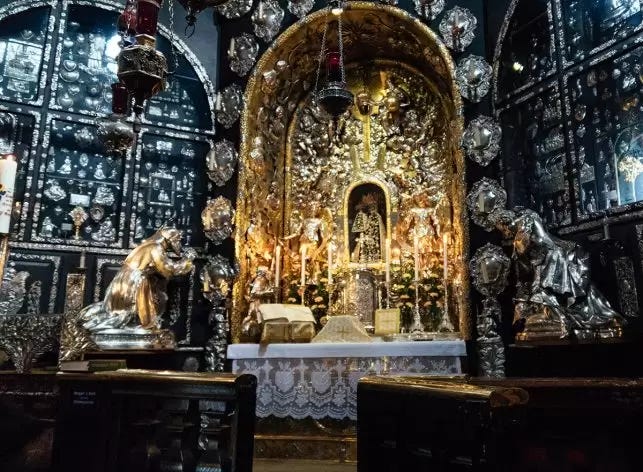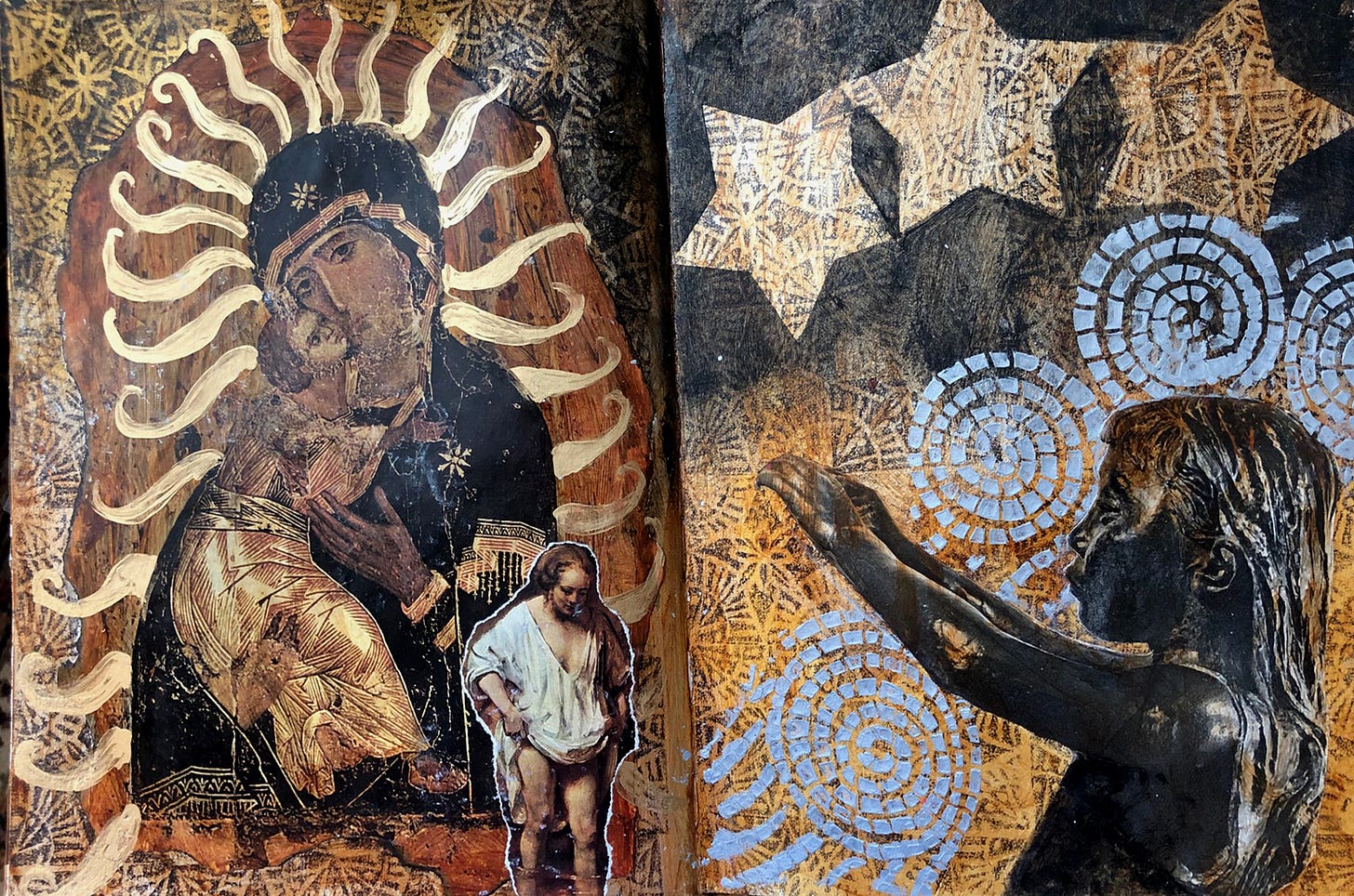If you liked reading this, feel free to click the ❤️ button on this post so more people can discover it on Substack 🙏
In just a few days, on July 22nd, we will celebrate the feast day of St. Mary Magdalene, which the Catholic Church has (finally) officially recognized. On June 10th, 2016, the liturgical celebration honoring St. Mary Magdalene was raised from a memorial to a feast, putting her on par with the Apostles.
Occasionally you will hear Mary Magdalene called the Black Madonna, meaning the Secret or Hidden Madonna. The Hidden Madonna is a tradition in the south of France, where she was supposed to have washed ashore after having fled or been exiled from the Holy Land after the crucifixion. There are various accounts, but for those familiar with Dan Brown's The DaVinci Code and other speculative works, Mary Magdalene was pregnant with the child of Jesus. Thus she is the Hidden Madonna, eclipsed by the orthodox Madonna, Mary, the Mother of Jesus.
Whether none, some, or all of this is true is not the point. The fascinating thing is how female figures from the Gospel stories continue to turn up in legend and take on cosmic and goddess-like qualities. Our entire collective human heart longs for the feminine in the form of a Great Mother.
Going back to prehistoric times, black was the symbol for the earth and the Great Mother, the source of heaven and earth. The darker earth is, the more fertile, hence black is the color of fertility and creative power. But the ancient peoples knew that that which has power to create and to bring forth life also has power to destroy. Hence black also became the color of death and destruction. So the Great Dark Mother became known as "the Gate of Life" which opens both ways, to life on earth and to death, or life in the Goddess after physical death. ~ Ella Rozett
At this time of the year, when summer is ripe, complete, and at its most maternal, the Black Madonna makes herself known most conspicuously. It is now that I find myself looking, longing, and lovingly drawn back to the arms of The Blessed Great Mother. She appears to me everywhere. In every flower, ripening berry, glossy black snake, young fledgling bird, adolescent rabbit, seed-laden grass, arching bramble, plump peach, and yellowing pear.
Afternoon summer rains leave the soil dark, rich and moist. Veils of mist rise from the damp earth when the sun breaks through the storm clouds, and the waters of streams, ponds, and oceans warm like the waters of the womb. This is the manifestation of The Black Madonna.
Every archetype has its seasons. They come and go according to the deepest, often unconscious, needs of the psyche, both personal and collective. Today the Black Madonna is returning. She is coming, not going, and she is calling us to something new (and very ancient as well). The last time the Black Madonna played a major role in Western culture and psyche was the twelfth century Renaissance, a renaissance that the great historian M.D. Chenu said it was the "only renaissance that worked in the West." It worked because it was grassroots. And from this renaissance was birthed the University, the Cathedral, and the city itself. She brought with her a resacralization of culture and a vision that awakened the young. In short, it was the last time the Goddess entered Western culture in a major way. ~ Rev. Matthew Fox
Maddeningly or perhaps marvelously, the various Marys in the old Gospel stories are sometimes conflated and often misconstrued, whether in the text itself, later commentaries, or the popular imagination. Mary Magdalene suffered from this phenomenon, having unfairly and incorrectly been branded a prostitute for centuries before the error was acknowledged and corrected.
However, on the marvelous side, the indistinct personalities and scant records of any of the Marys in traditional and gnostic sources leave plenty of room for personal gnosis, including intimate and individual experience, spiritual insight, understanding, and visionary perception of who and what constitutes the Black Madonna. This deep darkness of identity shrouded in mystery is very much in line with the concept of The Balck Madonna and hints at the need that such a figure meets within the soul. Like nature, she is feminine, motherly, powerful, and mysterious.
Underneath all our conditioning, hidden in the crypt of our being, near the waters of life, the Black Virgin is enthroned with her Child, the dark latency of our own essential nature, that which we were always meant to be. ~ Ean Begg, The Cult of the Black Virgin
According to theologian Matthew Fox the Black Madonna is, in fact, the Queen of Nature. She acts in the world as the agent of fertile transformation. Her influence is felt in the fields and forests as well as in the psyche. Her urgent message implores us to restore balance and wholeness to the land. She seeks in us a renewed honoring of the earth and her children. In so many ways, her return to our collective consciousness is a sign of the critical and catastrophic times we live in.
Deep Roots and Mother Goddesses
Mary, the Mother of God, as opposed to Mary Magdalene, is most often the Balck Madonna. All across Europe, chapels, cathedrals, and shrines house a statue of the enigmatic Black Madonna. They are usually very, very old and associated with mighty miracles. Many of them are seated on a throne, gazing directly at you. Others stand holding their divine child in one arm.
The Black Madonna's roots are thought to go back to religions that spanned Europe and the Mediterranean long before Christianity. Cathedrals, churches, and shrines with Black Madonnas were often once pagan shrines to Diana, Artemis of Ephesus, and Cybele. There is often an uncanny similarity between some Black Madonna figures and the Egyptian Goddess Isis with her infant son Horus seated on her lap. This resemblance shows the influence of changing faiths and religious traditions while the underlying iconography remains essentially the same. If we follow the roots back even further, we may find ourselves face to face with the archetypal Earth Mother, the mighty feminine force in the Universe.
The shrines and images of the Black Virgin have an undeniable spiritual power, which explains their attraction for tourists, as well as those seeking a cure for their ills." ~ Ralph Metzner.
In the cathedral in Chartres, France, there are two Black Madonnas. One is Notre Dame de Pilar, a 16th-century copy of the original from the 13th century. She stands in a side chapel in a golden gown surrounded by candles. The other is Notre Dame de Sous-Terre, "Our Lady of the Underground." You can find her deep in a crypt near a holy well from pre-Christian days. Sadly, during the French Revolution, she was destroyed, but in 1856 a replica was created to take her place.
I have a small copy of Notre Dame Sous-Terre, Our Lady of the Underground. She is a beautiful, commanding queen seated upon a throne with her divine child on her lap, just like Isis and Horus. She looks squarely out at you with power and presence. Her posture is reminiscent of the seated Great Mother Goddess of Catal Huyuk upon her lion throne. Catal Huyuk was a proto-city settlement in southern Anatolia, which existed from approximately 7500 BC to 6400 BC and flourished around 7000 BC. This Great Mother Goddess can also be found in Greco-Roman statues and through the Black Madonna into the Christian period. Indeed she is still with us today.
The chapel in Altötting, in the lush, fertile farm country of Lower Bavaria, stands in the middle of the town square, surrounded by other churches and monasteries. The outside of the chapel is covered with thousands of votive tablets. The entire inside of the chapel is painted black, and the walls studded with countless gold and silver images and ornaments, especially around the alcove shrine which holds the statue. The light from numerous candles in gigantic silver candleholders sparkles and scintillates off the polished gold and silver objects. The blackness set with shimmering gold and silver gives the whole chapel a mysterious yet strangely comforting aura.~ Ralph Metzner
Central to Altötting is the Black Madonna. A small image of Mary dating back to the 13th century and encrusted with gold and gems (up until the 15h century, she was clad in the remains of the wedding gowns of the Bavarian princesses, though). Many wonders are attributed to the Blessed Mother, and it's the main reason all those pilgrims come to Altötting.
Now, you may believe what you want, but upon entering the Chapel of Grace, you are left speechless by the intensity of the atmosphere. Here, eons of religious devotion become palpable. It's a weird feeling hard to capture with words, but it's almost as if nodes of power converge here to press upon your very being. ~ Années de Pèlerinage
The Black Madonna, Mystery and Meaning
The ground of the soul is dark. ~ Meister Eckhart
The Black Madonna calls us to the darkness, for divinity resides in the dark.
Currently, popular spirituality is plagued by the "good vibes only" and "love and light" crowd. Enlightenment is seen as a banishment of darkness or shadow when the only path to enlightenment is reconciling and integrating light and dark within ourselves. Dualism, while a convenient concept for describing the state of things, both inner and outer, is always undone by the ultimate reality of the Oneness of Divinity. The Black Madonna guides us into the dark, where we find the problematic, sorrowful, awful, and terrible and the bubbling, protective, mysterious, potential-filled void of darkness that births all things. We need the dark, or the light becomes a shallow escape into infantile fantasies, which causes the psyche to crumble at the first wound or challenge. Perpetual light may cause seedlings to grow quickly, but they become tall and spindly rather than robust and resilient with well-developed roots. The Black Madonna is the heart of courage, guiding us deep into the mysterious unknown of our souls so we can come face to face with ourselves and the authentic truth of who we are. Paradoxically, darkness is the place to find the light of divinity.
...the blackness of divine mystery, that mystery celebrated by the great Aphophatic mystics, such as Dionysisus Areopagite, who see the divine as forever unknowable, mysterious, beyond all our concepts, hidden from all our senses in a light so dazzling it registers on them as darkness. ~ Andrew Harvey
The call to darkness guides us from the celestial realms and the upper chakras of the throat, third eye, and crown down to the lower chakras and the soil, bones, stones, caves, and caverns of the underworld. We connect to her when we engage with earth, animal, mineral, blood, birth, and death. She guides us on a path to wholeness through the gritty, messy reality of being an incarnate being and reconciling that existence with our spark of divinity and all that implies. By spending time tending our lower chakras, the first being survival and ancestors, the second sexuality and creativity, and the third a sense of self and personal integrity and power, we begin to understand the message and meaning of the Black Madonna. She is the throne we are invited to sit on, anchoring us to the earth while lifting us toward heaven.
Like every good mother she teaches her children how to survive in the world with all of its challenges and sorrows while holding in her heart prayers for their blessing, success, prosperity, and ultimately, their development into all they can possibly be and achieve.
The Cosmic Mother
Mary Magdalene and the Virgin Mary have all transcended their original appearance in ancient texts as mere mortals and have come to reside in the realm of the archetypes, the world of the transpersonal, transcendent, and cosmic. Because of this shift, they can both fit comfortably in the symbol of The Black Madonna. She and they have become a whole that is greater than its parts.
Our ancient, battered, much-loved, little-understood Black Virgins are a still-living archetypal image that lies at the heart of our civilization and has a message for us. The feminine principle is not a theory but real and it has a will of its own which we ignore at our peril. ~ Ean Begg, The Cult of the Black Virgin
An Invitation to Explore
During this season of The Black Madonna, which opens on July 22nd, with the Feast Day of Mary Magdalene and continues through Lammas, August 1st, spans Leo and Virgo seasons (think the Strength card in the Tarot) and ends with Persepohone's descent into the Underworld on the autumn equinox I invite you to explore The Black Madonna, who she is to you and what she brings to your spiritual journey right now.
How is darkness a path to divine light?
How have you experienced your connection to the earth, the physical, and the feminine as part of your spiritual development?
Everyone from Popes, kings, mystics, and ordinary folk have had profound experiences with The Black Madonna, have you? Tells us in the comments section we'd love to hear your story.
The comments section is a safe and welcoming space to share your insights and experiences.
Comments and conversation are always appreciated and enjoyed, so feel free to let your voice be heard. I read them all and try to respond to each one.
Thank you for reading Hedge Mystic and participating in this vibrant and growing community of creative, spiritual humans. You are always welcome here, appreciated, and loved.
If you liked reading this, feel free to click the ❤️ button on this post so more people can discover it on Substack 🙏
Discussion is encouraged. Leave your reactions and insights in the comments.













Richness here, Jan, and so much to take in. I love being reminded of the connection between the ripeness of earth in summer and the ripeness of fertility and femininity. This > "Our entire collective human heart longs for the feminine in the form of a Great Mother." I think is what makes most of us feel so fulfilled when we spend time in nature. And, then to also check in with the perpetual dance between light and dark, knowing that each are essential to wholeness - is such an important part of our reality to acknowledge. Only from that vantage point are we able to move through our challenges toward gratitude. Much appreciated!
I appreciate your well-researched and thoughtful article. I understand and feel the wisdom in rejecting dualism and investigating the “dark” elements in all of us. We are richer for integrating the dark. Congratulations for all the wonderful articles you write.